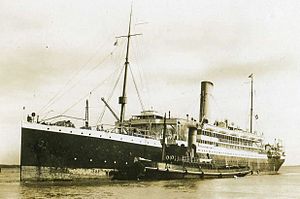 Aragon in 1908 as a civilian ocean liner
| |
| History | |
|---|---|
| Name |
|
| Namesake | The Spanish Kingdom of Aragon |
| Owner | |
| Operator |
|
| Port of registry | Belfast |
| Route |
|
| Builder | Harland & Wolff, Belfast |
| Yard number | 367 |
| Launched | 23 February 1905[1] |
| Completed | 22 June 1905 |
| Maiden voyage | 14 July 1905 |
| Out of service | 30 December 1917 |
| Identification |
|
| Fate | Sunk by torpedo 30 December 1917 |
| General characteristics | |
| Class and type | RMSP "A" series |
| Type | Ocean liner |
| Tonnage | |
| Length | 513.2 ft (156.4 m)[3] |
| Beam | 60.4 ft (18.4 m)[3] |
| Depth | 31.0 ft (9.4 m)[3] |
| Installed power | 762,[5] 827[3] or 875[1] NHP |
| Propulsion |
|
| Speed | |
| Boats & landing craft carried | 12 lifeboats, 1 dinghy, 1 gig |
| Capacity | |
| Crew | As troop ship: 200[3] |
| Armament | 2 × stern-mounted QF 4.7-inch (120 mm) guns (from 1913)[6] |
| Notes |
|
HMT Aragon, originally RMS Aragon, was a 9,588 GRT[3] transatlantic Royal Mail Ship that served as a troop ship in the First World War. She was built in Belfast, Ireland in 1905 and was the first of the Royal Mail Steam Packet Company's fleet of "A-liners"[7] that worked regular routes between Southampton and South American ports including Buenos Aires.[2]
In 1913 Aragon became Britain's first defensively armed merchant ship ("DAMS") of modern times. In the First World War she served as a troop ship, taking part in the Gallipoli Campaign in 1915. In 1917, a German submarine sank her in the Mediterranean, killing 610 of the personnel aboard.
- ^ a b c d e f g "Aragon". North Coast Shipwrecks. Shipwrecks of Egypt. Retrieved 9 April 2013.
- ^ a b Seligmann 2012, p. 144
- ^ a b c d e f g h i Lettens, Jan (9 November 2009). "SS Aragon [+1917]". The Wreck Site. Retrieved 9 April 2013.
- ^ a b c d e f "1914–1926". Royal Mail Steam Packet Company. Merchant Navy Officers. Archived from the original on 11 June 2011. Retrieved 9 April 2013.
- ^ Cite error: The named reference
SASwas invoked but never defined (see the help page). - ^ a b Seligmann 2012, p. 132
- ^ "Royal Mail to Plate". Ships-Worldwide.com. Trains-WorldExpresses.com. 2012. Retrieved 9 April 2013.